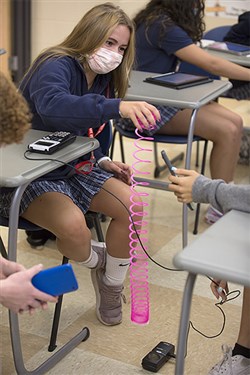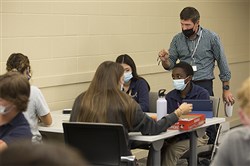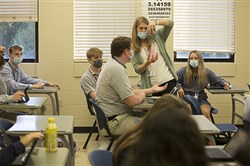VOL. 45 | NO. 40 | Friday, October 1, 2021
Lessons in supply, demand
By Hollie Deese
It didn’t take long for word to spread among parents in Sumner County that Pope John Paul High School was expanding its offerings to add middle school instruction for the 2021-2022 school year, opening up 198 spaces in sixth, seventh and eighth grades.
“We were specific to 198,” says Mike Deely, head of Hendersonville Catholic school, known colloquially as JPII. “We looked at the use of the campus and what we can fit in and how we’re going to maximize the use of the space.”
Private schools across the Midstate are stretched thin to accommodate the influx of students coming to the Nashville area. Families streaming into Middle Tennessee, often with parents moving here to work at high-quality, high-paying jobs at places like Amazon or AllianceBernstein, see value in paying for their children’s education. They want schools that fit their ideals or are similar to what they had in California or New York or have schools with special programs.
Finding a school that can handle COVID – even during a surge – also has been top of mind with parents looking for a safe, valuable fit.
At JPII, it didn’t take long for all 198 of the middle school slots to fill up before school started this year. Heading into fall break, all grades have wait lists – even the high school, where classes have historically been kept at around 130 each.

Pope John Paul II student Remi Schimmel works with classmates to record movement using a Slinky.
-- Photo By Michelle Morrow |The Ledger“We have older kids moving here, brothers and sisters, and it’s just created a demand,” Deely points out.
And while it is tempting to want to try and squeeze in another student here or there, he says maintaining that high school class size is just as important as starting slow while building out the middle school program.
“We really want to start off small and make sure we’re doing it right, really get an idea of how it works,” Deely says. “We didn’t want to rush it.”
But Sumner County has limited options for private schools even as its population, now at 196,281, 2020 U.S. Census data reveals, a 22% increase in the past decade.
“We have some good schools that feed into us, but the options are very limited compared to what we do find in other parts of the Nashville region – Williamson County and certainly in the Metro area,” Deely says.
Deely says the middle school expansion of JPII, which turned 20 this year, goes back to the foundation of the school. Early on it was not the immediate need for the area, but it has always been in the background.
The recent growth is one reason for expansion. But JPII is also part of the Roman Catholic Diocese, which saw local and national numbers fluctuate before the COVID pandemic.

Pope John Paul II accounting teacher Matthew Thigpen directs his class during an accounting activity.
-- Photo By Michelle Morrow |The Ledger“And as enrollment’s gone up and down with Catholic schools, there has been a lot of discussion about whether this a better model, particularly looking at how most of the other private schools run in Middle Tennessee,” Deely adds. “By the time most kids reach ninth grade, they are already fully committed to the arts, sports or other extracurricular programming in their local middle school program.
“There was a study done through the Miller Group that suggested many people look for a middle school that offers the academic program we offer, but with the options for the arts and the athletics and all the other things that we offer on campus. Middle school parents were interested in a lot of high school options, but appropriate for middle school,” he says.
At JPII that includes getting STEM certified, offering robotics and entrepreneurship programming and teaching students about investment and banking. And it also includes business development and hands-on work for students with special needs.
It was the allure of the advanced technology offerings that ultimately prompted Sam Stowers and her husband, Stewart, to transfer their son Jack from Sumner Academy to JPII for eighth grade year this year. And so far, they have been happy with their decision, and enjoying even more than the challenging curriculum.

Pope John Paul II middle school sixth graders Kelsie DuBois, left, playing “The Wolf,” and Claire Kurtzman, “Little Yellow Riding Hood,” rehearse their lines along with “busy bees” Ava DeJoseph and Paige Patterson.
-- Photo By Michelle Morrow |The Ledger“I like that they seem to have something for everyone in extracurriculars, from sports, to drama and arts to technology,” Sam Stowers says. “They really push the students to get in involved. I also feel like they made an effort to find the strengths and weaknesses of my child and place him accordingly.”
She has also been impressed with the balanced mix of male and female teachers, some new and enthusiastic, others with more experience, as well as the sense of belonging the schools seems to elicit in the students with energetic game days and a school “house” system (think Harry Potter) that has brought out some school enthusiasm in her child.
“We can do a lot of things for kids, but we do want to keep it affordable. We didn’t increase our high school tuition last year, and so we wanted to be really competitive with what we did with our middle school tuition too,” Deely says. “Fundamentally, that is one of the goals to keep that price point down as much as we can.”

Math teacher Amanda Peper separates Slinkies during a math lab at Pope John Paul II Preparatory School in Hendersonville.
-- Photo By Michelle Morrow |The LedgerMiddle school tuition at JPII this year is $11,700, with a $2,000 subsidy for Catholic families. Its high school tuition is $16,900, with the same subsidy offered. Definitely not free, but in some cases up to half the cost of some of Nashville’s well-known private schools.
“Those are phenomenal schools, but sometimes with schools, people see the value because it’s more expensive. I get that,” Deely says. “But we have similar goals. It is our Catholic identity that does define us, and we want to be unique in that.”
Private v. public in Williamson
While Williamson County has more private options than Sumner, its reputation for quality public schools is a draw for those moving into Middle Tennessee.
But maxed-out classes, even in the best school systems, don’t always appeal to parents. Add to that rolling COVID quarantines and closures, and parents will pay for something they view as more stable.
Robin Goertz, director of enrollment management at Battle Ground Academy in Franklin, says in the 10 years she has been at the school she has seen a steady growth of enrollment she attributes directly to the area’s growth and the addition of Will Kessler, the head of school for the past eight years who has focused on keeping existing families from leaving BGA for one of the area’s many other private options.
And there was another boost in admission the past two years as families looked for something different during COVID, Goertz says. “Now we’re about as big as we want to be.”
“We’ve always had increased interest in a certain grade, and we might not be able to accommodate everybody, but almost every grade had a wait pool this year,” she says. “We’ve always liked having spaces for family transitioning in the summer, and so that was tougher to not be able to accommodate as many families who had interest in BGA.
“And we’re already seeing at the beginning of this year, another kind of rush on interest for next year. It just hasn’t stopped.”
Because Williamson County has a reputation for strong public schools, BGA finds itself in competition with public and private schools in the area, Goertz explains.
Many parents made that public-to-private leap during COVID in order to be in an independent school that had more control over mitigation efforts like mask mandates and social distancing.
“I think the conversation that we’ve all had at admissions, whether it is COVID or growth related, is that it’s ‘easier’ for us to do some things for 880 students than Williamson County can do for 40,000,” she says.
“When we opened in person last year, and Williamson County was going to be remote, we knew we could do it because we know how big our classes are. We could cut it off at a certain point, spread out 6 feet and utilize space in different ways.”
Of course, future growth isn’t off the table for BGA either, Goertz adds.
“I think like every school we are looking at a 10-year master plan, and in that plan we do see growth,” she says. “Part of that would be looking at an early learning center. We start at kindergarten and I think down the road we might like to see some preschool growth. We are fortunate – we have land, and we could build a few more buildings.”
Which actually puts the school well ahead of some of the newcomer families who had to change their plans of attending BGA this year when they were unable to buy a house before school started.
She says nearly 30% of their inquiries last year were from families moving from out of state, with 5% of new enrollment representing new-to-Tennessee families.
“And then we had a handful of students who sent their enrollment contract but then they couldn’t find a house, at least four families,” Goetz says.
But BGA had no problem filling those slots immediately.
As private schools continue to expand and grow, they will be looking to do it in a way that isn’t so steeped in the past, but takes into account all the lessons learned during the pandemic.
“I actually feel that the challenges we have faced are going to reshape, and in some ways, improve education going forward, and that this generation, in as much as it’s been rough the last two years, may come out with a better sense of what does matter and what doesn’t matter in schools,” Deely says.
“We learned that social connection is one of the biggest reasons to keep the school open,” he adds. “We’re looking at future expansion, and that isn’t simply adding a classroom. It’s thinking about what the student gathering centers will look like. How will we gather in the future?
“As much as it’s been hard, I’m actually a little more optimistic that these challenges will shape us, that we’ll make some better decisions down the line.”